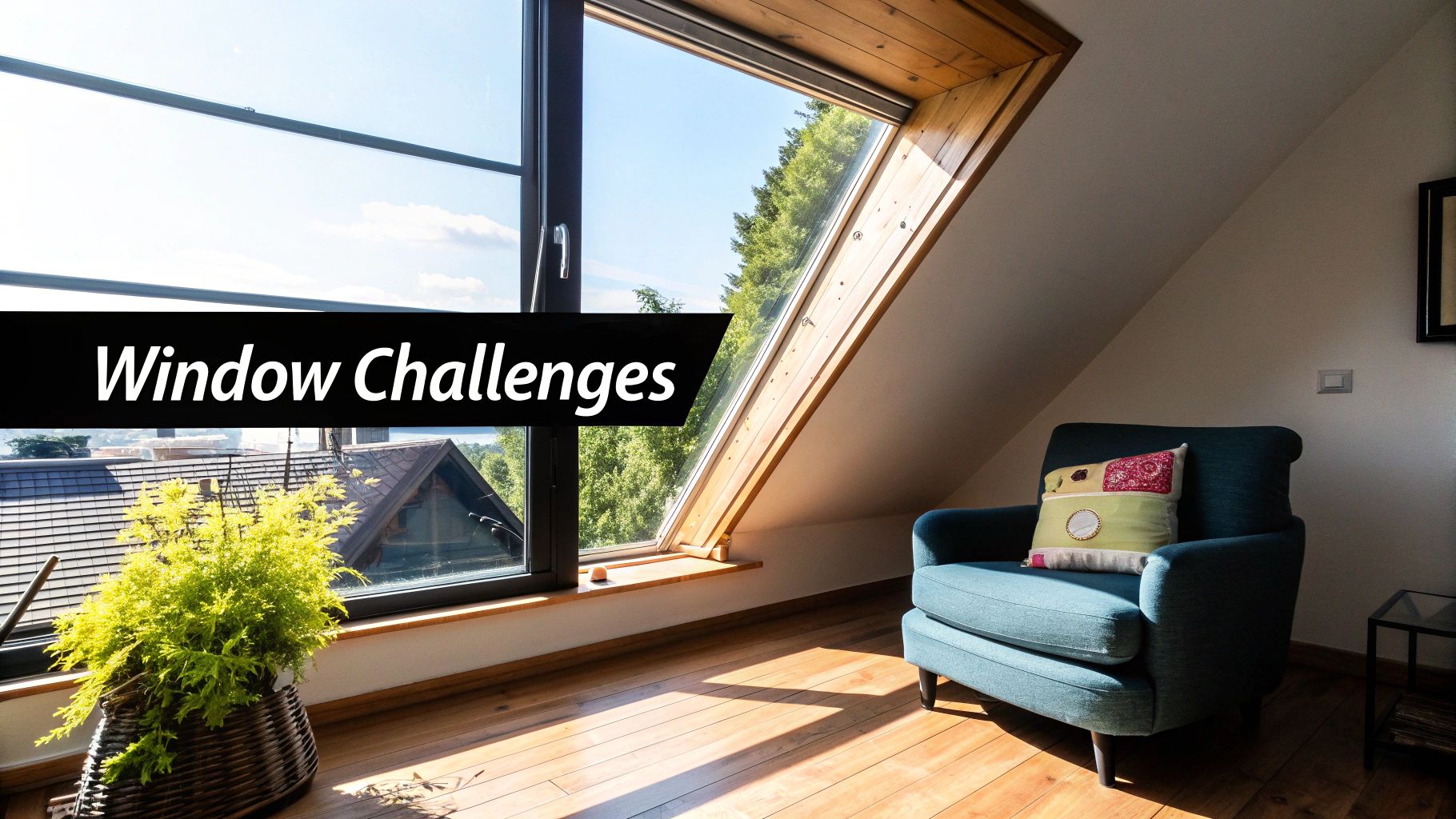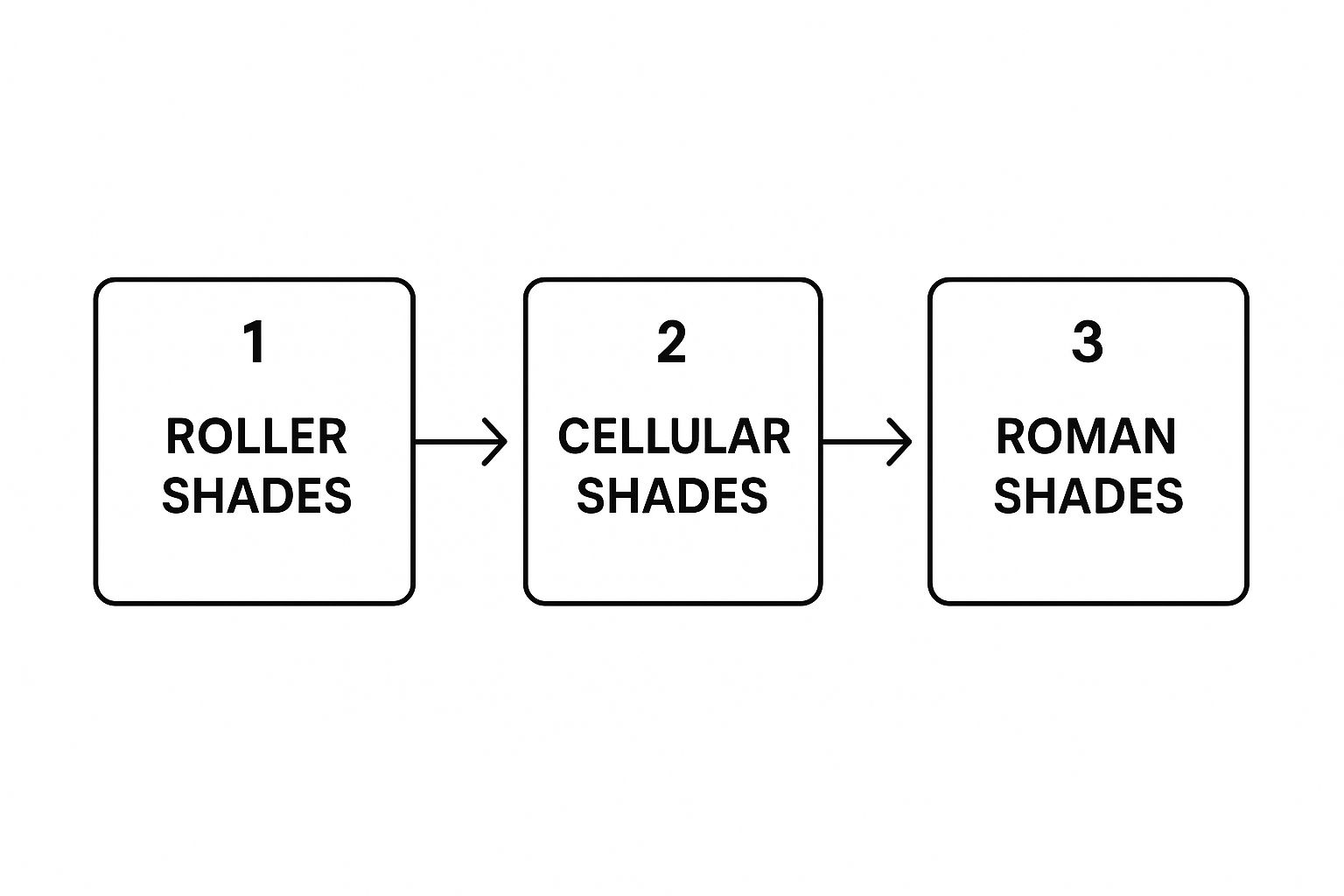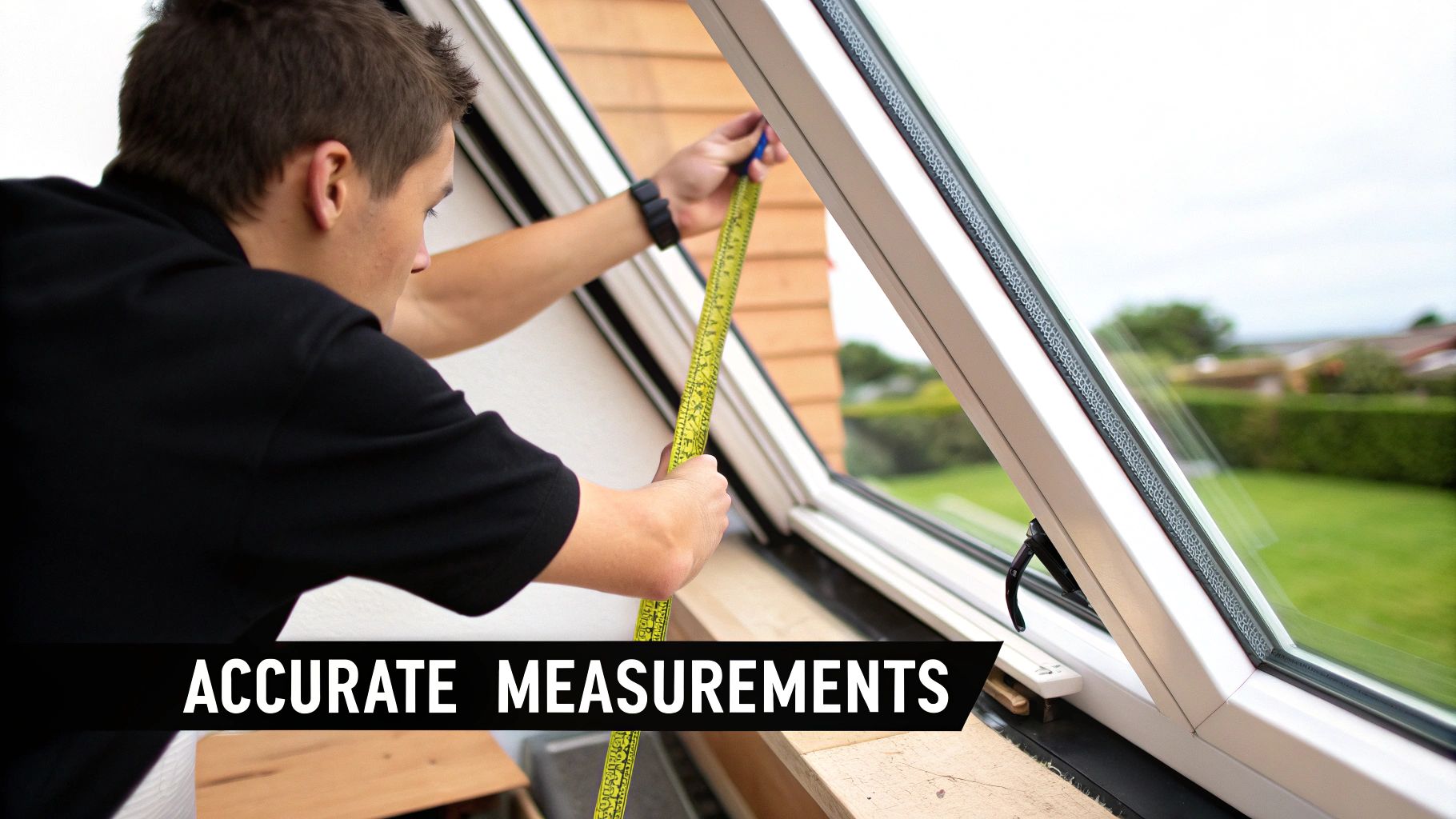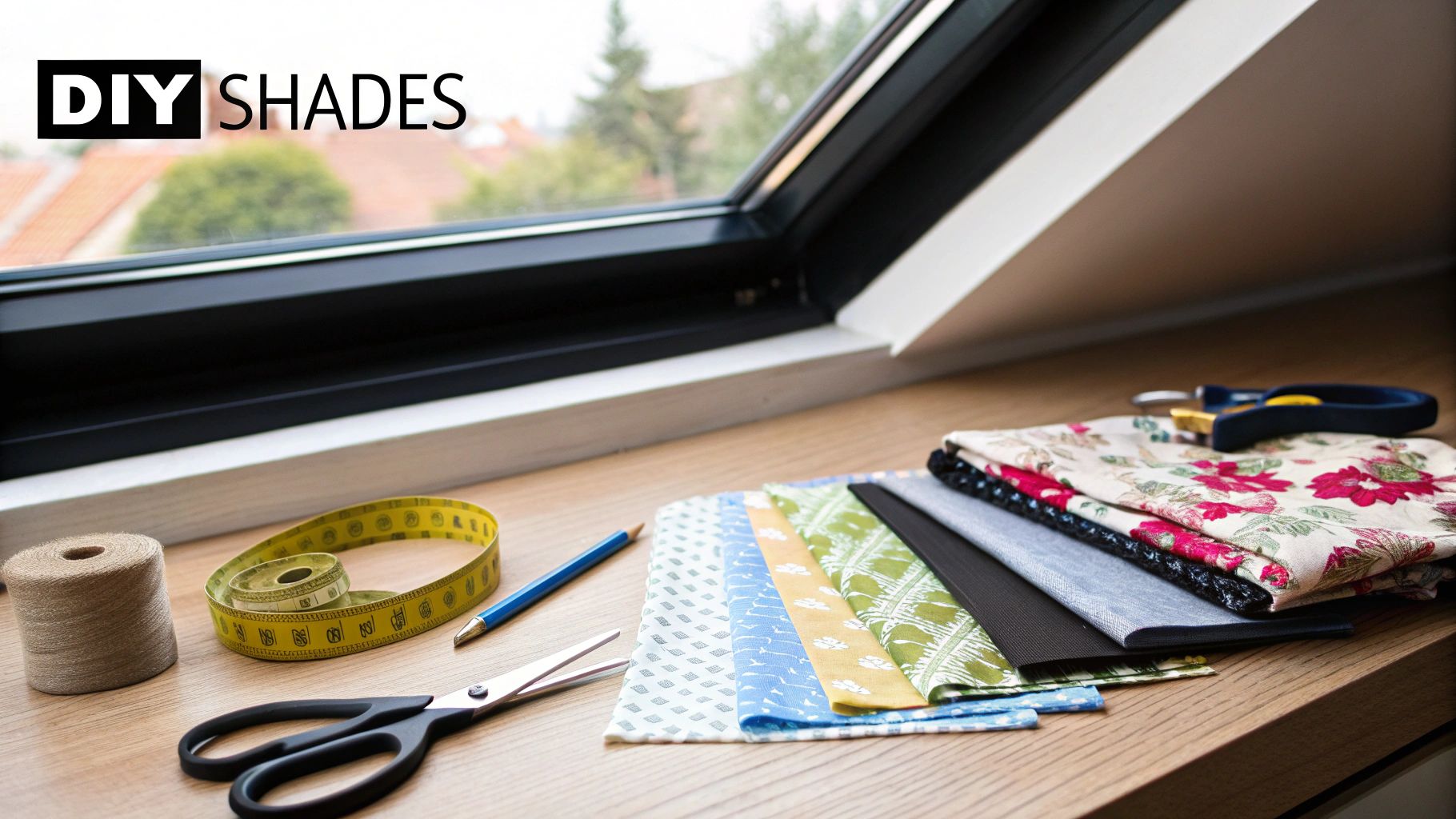Shades for Angled Windows: Expert Installation Guide
- Johann Reardon

- Jul 18
- 13 min read
Decoding Your Angled Window Puzzle

Those angled windows? Gorgeous, right? They add so much architectural interest. But let's be honest, they can be a real pain when it comes to window treatments. I've helped countless homeowners navigate this tricky design dilemma, and trust me, it's a whole different ball game compared to standard rectangular windows. Forget those off-the-shelf solutions – they just won't cut it.
A small triangular skylight, for example, has completely different needs than a sprawling angled cathedral window. You're dealing with unique angles and dimensions, which require a custom approach. That's why grabbing a tape measure and heading to the store usually leads to frustration.
Why Standard Shades Don’t Work
Standard shades are designed for straight lines and predictable sizes. Imagine trying to squeeze a rectangular shade onto a triangular window. You'll end up with gaps, awkward bunching, and a less-than-ideal look. The mounting hardware itself presents a challenge. Brackets might not align properly, or the shades might not operate smoothly on angled surfaces.
More often than not, you'll need specialized hardware, or even completely custom-made shades. This is actually a booming market; the demand for shades (including those for angled windows) is projected to reach $9.11 billion by 2032. The growing popularity of blackout shades for light control is definitely fueling this growth. Discover more insights on this market.
Understanding the Challenges
Measurements are just one piece of the puzzle. Fabric behaves differently on angles. Gravity becomes a major factor, and you might see sagging or bunching. This is where expert advice comes in handy. Companies like Home Blinds & Floors understand the nuances of fabric and hardware selection for angled installations. Their free in-home consultations are a game-changer, ensuring a perfect fit and smooth operation. Check out their helpful guide: How to Choose Window Treatments: Expert Tips for Every Room.
Different angles also bring unique challenges. A sharply angled window requires a different approach than one with a gentle slope. Thankfully, resources like Home Blinds & Floors offer a wide selection, from custom blinds and shades to motorized window treatments – all expertly installed. Understanding these complexities upfront can save you from expensive mistakes and ensure you get the beautiful, functional window treatments you deserve.
To help visualize these challenges, take a look at the table below:
Common Angled Window Types and Their Challenges: Comparison of different angled window styles and their specific measurement and installation considerations
This table highlights the variety of challenges posed by angled windows, emphasizing the need for tailored solutions. Each window type, from skylights to bay windows, presents specific considerations that influence the choice of shade style.
Considering these factors, finding the perfect shades for angled windows might seem daunting. But with the right guidance and resources, you can transform these challenging spaces into stylish and functional parts of your home.
Mastering Angled Window Measurements That Actually Work

This infographic gives you a visual guide to choosing shades for angled windows. It walks you through options like roller shades, cellular shades, and roman shades, pointing out the pros and cons of each for angled installations. Roller shades offer a clean, modern look and generally work well on angles. Cellular shades are a great pick if insulation and light control are your priorities. Roman shades, while gorgeous, can be a bit tricky on steeper angles because of the fabric folds.
Let's talk angled window measurements. This is where so many DIYers get tripped up. That trusty tape measure? It won't cut it here. After chatting with the installers at Home Blinds & Floors, I've got the inside scoop on getting this right. We're talking about accurately capturing those tricky angles, mounting depths, and clearances—the stuff manufacturers really need.
Why Multiple Measurements are Essential
Angled surfaces are rarely perfectly even. Taking measurements at multiple points isn't just a good practice—it's absolutely crucial. For example, an angled window that looks straightforward might actually have slight variations along the edges. If you only measure the widest point, you might end up with shades that are too big and won't fit. Also, think about how the angle itself might change along the window's height, especially in older homes. Taking consistent measurements at multiple points helps avoid those nasty surprises.

This screenshot shows the basic width and height measurements you'd take for a standard window. Helpful for rectangles, sure, but completely insufficient for angled windows. We need more information to account for the angles and ensure a proper fit. With angled windows, width and height just aren't enough.
Documenting and Communicating Effectively
Treat your measurements like a blueprint. Clear documentation prevents costly mistakes down the line. Pros often use diagrams and detailed notes, including specific angles and any potential obstacles. This level of detail is key for clear communication with custom fabricators. Want to learn more? Check out this article on how to measure for blinds. Home Blinds & Floors really shines in this department, taking precise measurements and documenting everything clearly to guarantee a perfect fit, even for tricky angled windows. They take all the guesswork out of it. Their personalized service and competitive pricing make them a solid choice.
Avoiding Costly Mistakes
I learned this the hard way. I once measured an angled skylight only at its widest point. The shade I got back was way too big and totally unusable. I had to get it remade, which cost a fortune. A simple extra step—measuring at multiple points—would have saved me all that trouble. Using Home Blinds & Floors’ expert measuring services eliminates these headaches. They’re a family-owned and locally operated business, offering a one-stop shop for both flooring and window treatments. Their wide selection of products and expert installation crews can really simplify a renovation.
Choosing Shade Styles That Embrace Your Angles

So, you’ve nailed down measuring those tricky angled windows. Now comes the exciting part: finding the perfect shades. Trust me, not all shades play nicely with angles. Some just don't work, while others truly shine. I've spent years figuring this out, so let me share what I've learned.
Cellular Shades: The Angled Window Winner
Cellular shades (also called honeycomb shades) are my go-to for angled windows, especially triangles. Their structure keeps them looking sharp and clean, even on steep slopes. As a bonus, they offer great insulation – a huge plus for skylights.
Roller Shades: Sleek Simplicity for Dramatic Angles
For dramatic, sloping windows, roller shades are a fantastic choice. The fabric hangs beautifully, creating a sleek and modern look. This is key for larger angled windows where any bunching or sagging would be instantly noticeable. Roller shades are also perfect if you're considering motorized options (more on that later).
Roman Shades: Elegant, But With a Catch
Roman shades can add a touch of elegance to slightly angled windows. But be careful with fabric choice. Heavy fabrics tend to droop, so stick with lighter materials or explore custom mounting options. This is where talking to the pros at Home Blinds & Floors can be incredibly helpful. They can steer you toward fabrics and mounting solutions that perfectly complement your angles.
Blackout Options for Angled Bedrooms
Angled windows in bedrooms present a unique challenge: balancing light control with style. Blackout shades are the natural solution, but finding the right fit can be tough. Accurate measurements are essential. For more info on blackout shades, check out this post: Discover the Best Blackout Shades for Perfect Light Control. Home Blinds & Floors offers a wide variety of custom blackout shades designed for angled windows, guaranteeing a perfect fit and optimal light blocking.
Motorization: A Game-Changer for Hard-to-Reach Windows
Motorized shades are practically essential for many angled windows, particularly high skylights or cathedral windows. No more struggling with awkward cords! They offer smooth, effortless operation, adding both convenience and a clean, streamlined aesthetic. Plus, the growing popularity of motorized and smart blinds is driving significant growth in the window coverings market, projected to reach $128.52 billion by 2034, up from $71.15 billion in 2024. You can find more market projections here. For all your flooring and window treatment needs, including an excellent selection of motorized options, Home Blinds & Floors is an excellent resource. Their expert installation team makes the whole process a breeze.
Custom Solutions and Professional Installation Secrets
Let's talk about those tricky angled windows. Even after meticulous measuring, sometimes standard shades just don't cut it. That's where getting a little creative, or even going full custom, comes in. I've picked up some tricks from seasoned installers over the years, and trust me, knowing the difference between adapting standard shades and opting for custom fabrication can save you both money and frustration.
Exploring Specialized Hardware
Angled windows often require hardware that goes beyond the usual. Think outside the box with things like adjustable brackets to compensate for uneven walls, extension arms to navigate around architectural features, and mounting systems specifically designed for smooth operation on slopes. These aren't your grandma's curtain rods! And here's a pro tip: when planning custom solutions, always consider future maintenance access. Just like choosing the right ceiling access panels for easy access, thinking ahead about how you’ll access your window treatments for adjustments or repairs is key. The folks at Home Blinds & Floors are experts at this, ensuring everything functions perfectly from the get-go.
They've got a knack for finding the right hardware for even the trickiest installations.
Fabric Considerations for Angles
Fabric can be a game-changer on angled windows. Heavy fabrics might sag, while lighter ones might billow excessively. Certain weaves and weights simply hang better on slopes. Understanding these nuances can prevent a lot of headaches down the road. For example, a light linen Roman shade might look stunning on a slightly angled window, but on a steeper slope, it might not fold correctly. Home Blinds & Floors shines when it comes to guiding clients towards the ideal fabric choices. They consider both aesthetics and functionality, drawing from years of experience and a deep understanding of how different materials behave in various situations.
Their expertise is invaluable in these situations.
Setting Realistic Timelines
Custom work takes time. There's no getting around it. Patience is your best friend here. But when it's done right, the results are well worth the wait. The demand for custom window treatments, including those for angled windows, is reflected in the growing global market. Currently estimated at $14.82 billion, it's projected to reach $24.63 billion by 2030, a 9.1% CAGR. This growth is fueled by a desire for energy efficiency, smart home technology, and personalized design. You can find more details about this market here. You might also find this helpful: Custom Blinds for Odd-Shaped Windows: Complete Solutions. Home Blinds & Floors understands this demand for truly tailored solutions. They offer in-depth consultations, carefully assessing your unique architectural challenges to recommend the best approach, whether it’s adapting a standard product or crafting a fully custom design. Their goal is to find your perfect solution and make the entire process smooth and stress-free.
To help you decide which route is best for you, take a look at this comparison:
To help you weigh your options, I've put together a comparison of standard adaptations versus going the custom route:
Standard vs Custom Shade Solutions Comparison: Cost-benefit analysis of standard adaptations versus custom fabrication for angled windows
This table summarizes the key differences in cost, timeline, ideal applications, and potential drawbacks of each approach. While adapting standard shades is a quicker, more budget-friendly option for slightly angled or standard-sized windows, custom fabrication provides the flexibility and perfect fit for unique architectural challenges.
Solving Installation Problems Before They Happen

Let's be honest, even when you've measured everything twice and planned down to the millimeter, angled window shade installations can still throw you a curveball. Sometimes the hardware just doesn't sit right, the fabric bunches in weird spots, or things stop working smoothly after a while. Trust me, I've been there! After troubleshooting countless installations, I've picked up on some common issues – and thankfully, some practical solutions that actually work.
Common Snags and Quick Fixes
One thing I see pretty often is slightly misaligned hardware. This can happen even with careful measurements, particularly in older homes where the walls might not be perfectly level. A little tweak with some shims or carefully repositioning the brackets usually does the trick.
Another frequent headache is fabric bunching, especially with shades for angled windows tucked into corners or on steep slopes. Adjusting the tension or even using small clips to redistribute the fabric can work wonders.
If you’re noticing operational quirks, like the shade not moving smoothly, start by checking for obstructions or loose components. You'd be surprised how often a simple tightening of a screw solves the whole problem. You might also find some helpful tips in our guide on motorized blinds.
When to Call in the Pros
While some problems are easy DIY fixes, there are times when it's best to call in reinforcements. If you're dealing with complex hardware, major fabric issues, or motorized shades that are acting up, contacting the professionals at Home Blinds & Floors is a smart move. Their team has the experience to handle these challenges effectively and efficiently, saving you a lot of time and potential damage to your shades. Their expertise in custom blinds and shades, particularly for tricky installations like angled windows, is invaluable.
Preventing Problems from the Start
As they say, an ounce of prevention is worth a pound of cure. Using high-quality hardware specifically designed for angled installations is key. When you're in the planning stages, checking out resources like those discussing Construction Drawings can help you anticipate potential challenges. Making sure those brackets are really secure and everything operates smoothly from the get-go can prevent headaches down the line. Home Blinds & Floors offers expert installation services, ensuring a perfect fit and functionality for your angled window shades for years to come. As a family-owned and operated business, their personalized service and competitive pricing make them a solid choice.
Warranty Wisdom
Understanding your warranty is crucial. Knowing what’s covered and what’s not can really inform your decisions if problems do pop up. Home Blinds & Floors stands behind their products and installations, giving you real peace of mind. They’re your one-stop shop for window treatments, from custom blinds and shades to motorized options. They also offer a wide range of flooring, which is super convenient for home renovations. Don't forget that a little preventative maintenance, like lubricating moving parts, can go a long way in extending the life of your shades and avoiding warranty issues.
Keeping Your Angled Shades Beautiful and Functional
Your angled window treatments, whether they're sleek roller shades or custom cellular shades, are a worthwhile investment. And just like any investment, they need the right care to stay looking their best and working smoothly. Over the years, I've chatted with tons of homeowners, and the ones who keep their angled shades looking fantastic for years all have a few tricks up their sleeves. Think of it this way: a little bit of upkeep now can save you a lot of hassle (and expense) down the road.
Cleaning: Adapting to Angled Surfaces
Cleaning shades on angled windows isn't the same as cleaning standard ones. Dust settles differently on slopes, and getting to those high corners can be a real challenge. I've found that a telescoping duster with a microfiber head is a game-changer. It lets you reach those awkward spots without needing a ladder or risking damage to the fabric. For fabric shades, a gentle vacuum with a brush attachment usually does the trick, but tougher stains might require a spot cleaner specifically designed for your fabric. And don't neglect the hardware! A quick wipe with a damp cloth can prevent dust buildup and keep it from corroding.
Seasonal Adjustments and Preventing Wear
Seasonal changes can really affect your shades. Temperature swings cause fabrics to expand and contract, and hardware can settle over time. Home Blinds & Floors recommends checking the tension and alignment of your shades at least twice a year. A minor adjustment can prevent sagging or bunching. It's also a good idea to lubricate any moving parts like hinges and rollers. A drop of silicone lubricant can keep things running smoothly and prevent them from wearing out too quickly.
Recognizing Warning Signs and Upgrading Smartly
Like your car, knowing how to spot early warning signs with your shades can prevent bigger problems later. Does the shade stick or move unevenly? Is the fabric starting to fray? These could be signs of more serious issues. Addressing these small issues early on is almost always cheaper than replacing the entire system. Sometimes a simple hardware upgrade can make a big difference. For example, upgrading to motorized window treatments from Home Blinds & Floors can resolve many common operational issues with angled windows and modernize your window coverings. Their expert team can help you choose upgrades that provide the most value, maximizing your maintenance budget and extending the life of your window treatments.
Choosing Home Blinds & Floors is more than just buying shades; it's about gaining a partner who can help you maintain your investment. They understand the unique challenges of angled installations and offer continued support to ensure your window treatments keep looking and functioning just how you envisioned. They have a vast selection, from custom blinds and shades to hardwood flooring installation. And as a family-owned and locally operated business, they're truly invested in their customers' satisfaction.
Your Complete Angled Window Action Plan
So, you’re ready to tackle those tricky angled windows? Great! Let’s walk through how to get from “window woes” to “window wow!” This isn't a rigid step-by-step, but more of a friendly guide from someone who’s been there.
Essential Measurements and Supplier Expertise
First things first: double-check those measurements. With angles, it's not just about width and height. You need to consider the depth of the window frame, the angle of the slope, and any quirks in the wall. I remember one project where the angle changed slightly halfway up – talk about a surprise! When you’re chatting with suppliers like Home Blinds & Floors, don't be shy. Ask about their experience with angled installations. A good question to ask is, "What type of hardware do you recommend for a steep slope like mine?" Their answers will tell you a lot.
Realistic Timelines and Budget Planning
Custom window treatments, especially for angled windows, take time. Don't expect a next-day miracle. Quality craftsmanship requires patience. Trust me, I've learned this the hard way! Rushing can lead to mistakes and ultimately cost you more in the long run. Speaking of cost, angled window treatments often require specialized hardware and custom fabrication. Be upfront with your budget, and a reputable supplier like Home Blinds & Floors will work with you to find solutions that fit. They're a family-owned business, so they understand the importance of value.
Vendor Evaluation and Avoiding Pitfalls
Choosing the right vendor is key. Don't just go with the first company you find. Look for experience and a solid reputation. Home Blinds & Floors has 20 years of experience and carries top brands like Hunter Douglas and Norman. Plus, they offer free in-home consultations – they bring the showroom to you! This is a huge help with angled windows. They handle everything from measurements to installation, minimizing those pesky pitfalls that can pop up.
Ready to finally love those angled windows? Schedule a free consultation with Home Blinds & Floors and see the difference experience makes.

.avif)
Comments